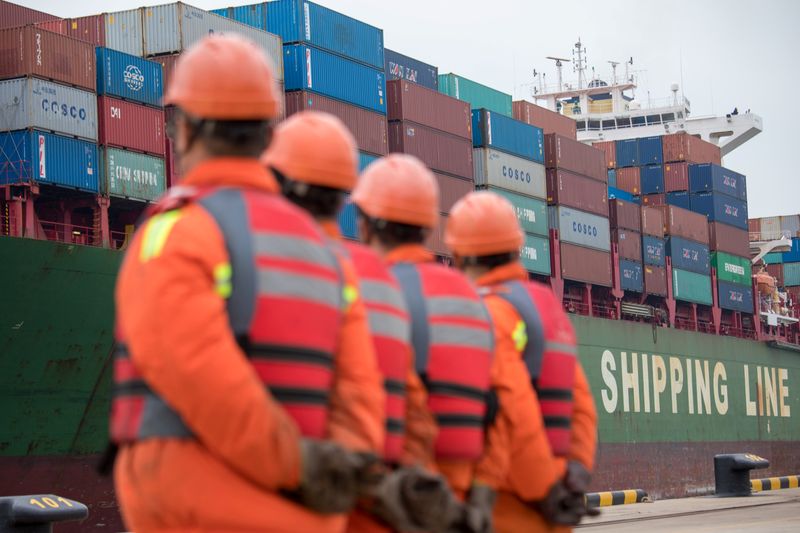By Joe Cash
BEIJING (Reuters) - China's exports and imports returned to growth in April after contracting in the previous month, signalling an encouraging improvement in demand at home and overseas as Beijing navigates numerous challenges in an effort to shore up a shaky economy.
The data suggests a flurry of policy support measures over the past several months may be helping to stabilise fragile investor and consumer confidence, though analysts say the jury is still out on whether the trade bounce is sustainable.
Shipments from China grew 1.5% year-on-year last month by value, customs data showed on Thursday, in line with the increase forecast in a Reuters poll of economists. They fell 7.5% in March, which marked the first contraction since November.
Imports for April increased 8.4%, beating an expected 4.8% rise and reversing a 1.9% fall in March.
"Export values returned to growth from contraction last month, but this was mainly due to a lower base for comparison," said Huang Zichun, China economist at Capital Economics.
"After accounting for changes in export prices and for seasonality, we estimate that export volumes remained broadly unchanged from March," she added.
In the first quarter, both imports and exports rose 1.5% year-on-year, buoyed by better-than-expected trade data over the January-February period. But the weak March figures prompted concerns that momentum could be faltering again.
And a high statistical base seemed to have weighed heavily on last month's brighter numbers, given that production had jumped in March 2023 as many workers recovered from a wave of COVID infections.
"Exports have been the bright spot in China's economy so far this year. The weak domestic demand led to deflationary pressure, which boosts China's export competitiveness," said Zhang Zhiwei, chief economist at Pinpoint Asset Management.
Most China watchers say that Beijing has its work cut out as consumer inflation, producer prices and bank lending for March showed that the world's No.2 economy has a soft underbelly. Moreover, a protracted property crisis remains a drag on overall confidence, spurring calls for more policy stimulus.
Rating agency Fitch cut its outlook on China's sovereign credit rating to negative last month, citing risks to public finances as growth slows and government debt rises.
The Politburo of the Communist Party, the party's top decision-making body, said last month it would step up support for the economy with prudent monetary policy and proactive fiscal policies, including through interest rates and bank reserve requirement ratios.
Beijing has set an economic growth target for 2024 of around 5%, which many analysts say will be a challenge to achieve without much more stimulus.
China stocks rose on Thursday off the back of the trade data, with the blue-chip CSI 300 index up 0.9% and Hong Kong's Hang Seng Index 1.1% higher after the midday break.
CHINA STOCKS UP
The headline import surge might not be all linked to domestic demand as shown by some stocking-up of goods by businesses.
"So far this year, the Chinese yuan depreciated the least among all major Asian currencies, which backs the strong import figures," said Wang Dan, chief economist at Hang Seng Bank China.
"Also, Chinese producers are stocking up on raw materials before prices go up," she added.
Shipments of coal into China were 45.25 million metric tons last month, up 11% year-on-year as power generators boosted their buying ahead of peak season for air conditioning consumption.
Iron ore imports also ticked up 1.1% last month, as lower prices in March encouraged some buyers to place orders for the key steelmaking ingredient betting demand and prices will pick up later in the year.
And soybean imports in April jumped 18% from a year earlier, as buyers snapped up cheap and plentiful beans from Brazil.
OVERCAPACITY PAINS
China's trade surplus grew to $72.35 billion, compared with a forecast of $77.50 billion in the poll and $58.55 billion in March
Chinese exporters had a tough time for most of last year as soaring interest rates weighed on overseas demand. With the Federal Reserve and other developed nations showing no urgency to cut borrowing costs, manufacturers may face further strains as they battle for market share.
Analysts say Chinese exporters are continuing to slash prices to maintain sales abroad amid the weak domestic demand conditions. In tandem, factories are also turning out too much, irrespective of whether buyers are out there.
Last month, U.S. Treasury Secretary Janet Yellen said that concerns are growing over the global economic fallout from China's excess manufacturing capacity.
The overcapacity problem has some analysts questioning the quality and sustainability of China's exports upturn.

"Overcapacity has pushed down export prices and fuelled the recent strength in exports. But with manufacturers’ profit margins already squeezed, their ability to slash prices has diminished and export prices are now bottoming out," Capital Economics' Huang said.
"The ongoing trade-weighted appreciation of the renminbi will pose further challenges."